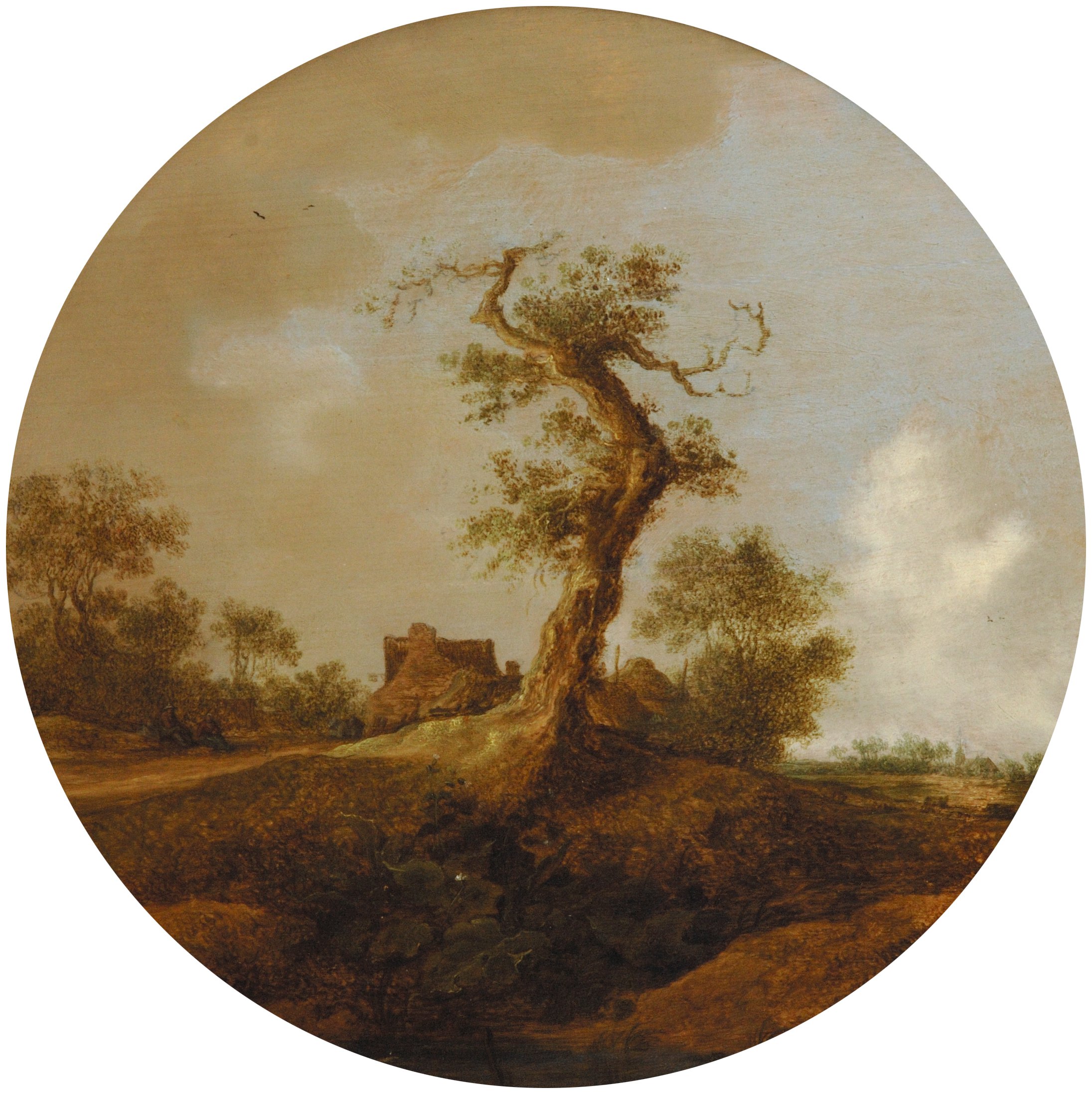17. Landscape with Tree and River Scene, by Anthonie Jansz van der Croos
 Anthonie Jansz. van der Croos (c.1606-1662/63), Landscape with Tree, n.d., Oil on panel, H 38.1 x W 38.1 cm. (No signature)
Anthonie Jansz. van der Croos (c.1606-1662/63), Landscape with Tree, n.d., Oil on panel, H 38.1 x W 38.1 cm. (No signature)
 Anthonie Jansz. van der Croos (c.1606-1662/63), River Scene, n.d., Oil on panel, H 38.1 x W 38.1 cm. (No signature)
Anthonie Jansz. van der Croos (c.1606-1662/63), River Scene, n.d., Oil on panel, H 38.1 x W 38.1 cm. (No signature)
This pair of seventeenth-century
Dutch landscape paintings hang either side of a fireplace in the President’s Lodgings.
It is unclear if they were intended as a pair, or if the round panels were designed
to fit a decorative domestic schema, but be it coincidence or not they have a
happy symmetry. The central trees seem almost to lean into the images, and the
lighter open sky that draws the eye through the image from the dark intensity
of the foregrounds has an enhanced heightening effect when the images are hung
in close correspondence.
Both works were given to St
John’s by Mrs Anna Derham at some point in the eighteenth century – she also
gifted Flowers in a Stoneware Vase by Jan
Brueghel the Elder.
Anna Derham was the mother of William
Derham, a Fellow of the college from 1724-48 and then President from
1748-57. At the point where St John’s acquired these works, landscape painting
was really only just becoming an acceptable genre of ‘fine art’ in Britain – it
had previously been considered a lowly form, more suited to amateur artists.
The identity of the artist has
been subject to more uncertainty. If, and it seems unlikely given the dates,
these paintings appear as two of the ‘landskips’ in the college’s 1728
catalogue they were attributed there to the Dutch painter Jan van Goyens
(1596-1656). In 1977, the art historian and Surveyor of the Queen’s Pictures,
Oliver Millar, described these works as ‘good little van Goyens’, possibly
influenced by the fact that the dimensions and frames are identical with two
works – Winter and Summer – painted by van Goyen in the
1620s. Van Goyen also painted dozens of circular landscapes, which suggests a
contemporary demand for the format. However, in 1989, George Gordon of
Sotheby’s suggested that in fact the artist was Anthonie
Jansz. van der Croos.
The confusion between the two
artists is easily understood as van der Croos was deeply influenced by van
Goyen. In particular, in both Landscape
with Tree and River Scene the
effect of evening light is brought about in part by a warm underpainting,
probably of a reddish or ochre-tinted light brown that infuses the whole tone
of the scene. Van Goyen’s ‘tonal school’
technique included this kind of tinted ground, and his work was known
for its contrasts between light and dark, often created by thinly painted dark
areas that would absorb light set again heavily treated areas of paint, often
using a white lead paint mix, which would reflect light back at the viewer in a
sometimes startling manner. The same kind of contrasting application and colour
effects can be seen here.
Both works have an immediately
accessible viewpoint – the viewer approaches the scene as if stepping into it,
looking up at the tree or across the canal in an unprivileged viewing that
offers instead an ordinary experience of landscape. This is not uninhabited
country, there are cottages, a church spire, and a boat. But it is almost a rural
idyll, and it has been argued that this kind of landscape painting arose
alongside the urbanization of Holland in the seventeenth century. At the same
time, the twisted form of the trees, which dominate the scenes, speak to an
arising thread in landscape painting in this period which was an interest in
the imperfect, the ruinous and decaying in the landscape. In his Schilder-boeck, published in 1604, Karel
van Mander described this as the ‘anti-beauty’ of a tangled form of landscape,
‘urging painters to notice ‘irregular shaped stones’, cascades tumbling ‘hither
and thither like a drunken man’ and trees ‘fallen down awkwardly’. By 1707 this
trend was so entrenched that Gerald de Lairesse, in his Groot Schilderboek, felt impelled to try and crush its influence as
a false equivalent ‘filled with misshapen trees, their branches and leaves
improperly splayed from east to west’.
The effect of the immediate
viewpoint and its connection between viewer and scene, is also to lower the
horizons such that the skies in Dutch landscapes of this period dominate in an
extraordinary fashion. They open both literally as a space for extending the
scene, via the effects of light, beyond the tangible landscape, and also open a
metaphoric space for the presence of God in the landscape. The cloud formations
in Landscape with Tree and River Scene are improbable, but they
allow the painter to set the lightened distance against varying darker tones,
including the pale grey of the middle-distance clouds that ease the passage of
the works from the dark roots and water through to the illuminated sky.
Although the evenings are drawing
in, these paintings remind us that there are brighter moments ahead – perhaps
something important to dwell upon at this point in term.
View River Scene on Art UK here.
View Landscape with Tree on Art UK here.
 Dr Jennifer Johnson, Junior Research Fellow in History of Art
Dr Jennifer Johnson, Junior Research Fellow in History of Art